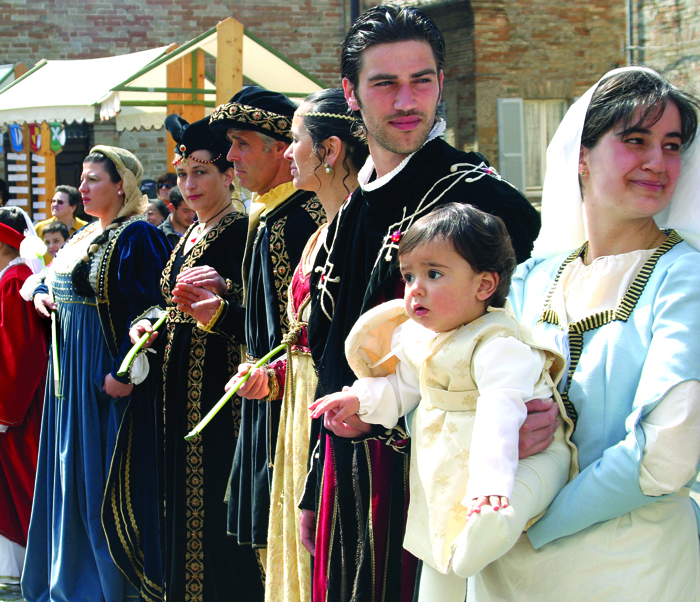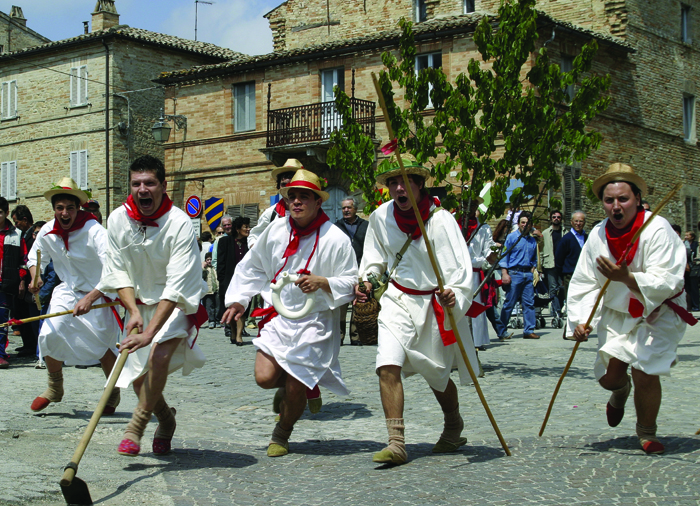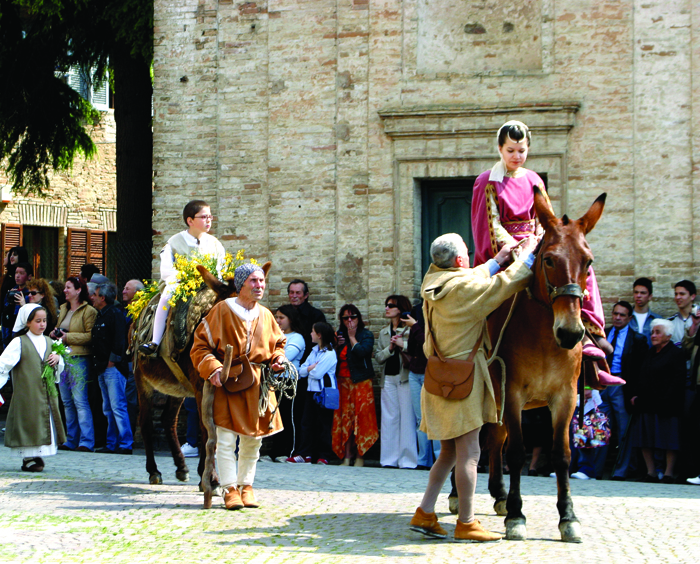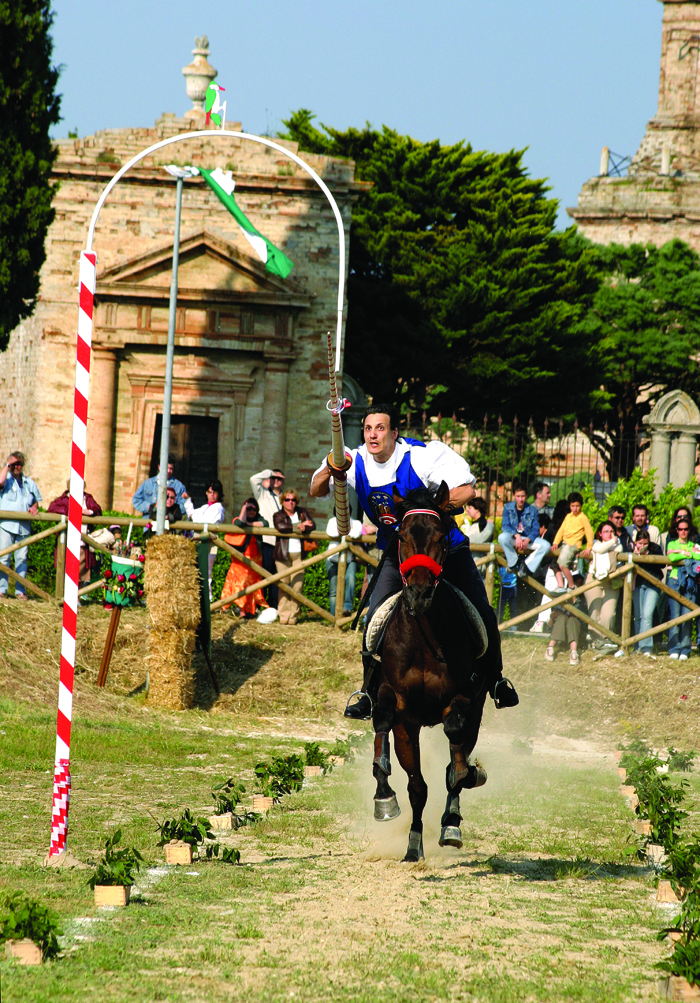Every year a festival takes place in Monterubbiano in Le Marche. We trace the history of the flight of the woodpecker.

The game takes place in the afternoon, always on the Sunday of Pentecost (the seventh Sunday after Easter), and always in the small town of Monterubbiano, near the Adriatic coast. Four men, on horseback race through the village collecting rings. There are 12 rings to be collected, arranged on four different levels, three rings per level. Each man takes it in turn to tackle the course, collecting as many rings as he is able, using a lance to pick them up. The winner, as one would suspect, is the man
with the most rings, and he collects his prize – a ring made of solid gold – before being paraded around the village centre in a horse-drawn cart during just one of the
processions that makes up the Sciò La Pica festival.
The origins of the festival are much debated. One school of thought suggests that it refers to a pica, or gazza (a magpie) that sat inside a cage hung on the branch of a cherry tree as it was paraded around the town by members of the Zappaterra (one of the guilded trade organisations of medieval times). On the other hand, there are those who believe that it makes reference to a picchio (a woodpecker) that guided the Sabines on their way to the land of the Piceni and a new life following their troubles in Lazio. Carrying a piece of reed (or, some say, a twig from a cherry tree) in its beak, the woodpecker would occasionally land, and where ever it did so the Sabines would build a new settlement.
The colourful festival held in Monterubbiano is typical of those that take place every year across Italy. Each region in the country celebrates something related to the area at some point during the calendar, and within the Ascoli di Piceno (the part of Le Marche within which the medieval town of Monterubbiano lies), there are five or six well-know festivals alone. As Giorgio Tegazi, one of the Sciò la Pica organisers, explains: “The festivals continue to be held today because they have been carried out through the generations to pay honour to our ancestors, and because they fill the towns and cities with a great sense of community spirit.”

The Sciò la Pica takes place over two days – the Pentecostal Sunday and the following Tuesday; however, the start of the festival itself is celebrated the Sunday before Pentecost with a livestock market in the town centre. “On the morning of the Pentecost the celebrations start with a procession from the village square – one kilometre from the church. The procession follows four men, dressed in traditional medieval costume, carrying candles. Once they arrive at the church the men offer the Madonna del Soccorso the candles as a mark of respect. The men,” Giorgio explains, “are chosen by their profession, offering the services of either a doctor, a mechanic or a shop keeper.”
Of course, that’s just the start of it. “In the afternoon there is another, more lively procession with lots of music and flag waving, marking the beginning of the festival game”. That’s the horse race/ring collection competition we briefly described earlier, topped off by the prize-giving and the third procession of the day. Things start to get really lively a couple of days later, on the Tuesday, when everyone makes their way down to the local park.

Then begins the Corporazione e con I Baccinali – a day-long party, essentially, which kicks off with breakfast in the park, where everyone gets a chance to talk and socialise. There’s medieval music, dancing and singing, which lasts until lunchtime, at which point everyone starts to go their own way – however, by this point a fair amount of wine has been consumed and many of the revellers are in the party mood, so to speak, and alternatives to simply going home are explored… “Most continue in the festive spirit by going to restaurants for lunch”, says Giorgio. “And then, after a long lunch, the festivities continue in the park, with more wine lasting until the evening.
Once it gets dark, the medieval entertainment continues, with fire breathing and juggling, acrobatics and flag displays, all taking place in the town square.” It would appear that the natives of Monterubbiano are not easily sated: “Overall there are two nights of excellent entertainment”, says Giorgio. So that leaves Sunday, Tuesday and then Wednesday for partying. You can’t imagine much is going to get done on the Thursday, either, given the amount of wine that gets consumed – or the Friday, for that matter…

On the whole the festival goes well, with little in the way of trouble or disruption to the merriment. However, there are the occasional hiccups: “Two years ago, two of the cows that are traditionally used in the Sunday Pentecostal procession broke free from the group and escaped through the crowd, out of the town and into the countryside. All the children were singing and shouting at the cows to stop. It came as a bit of a surprise as nothing like this had ever happened before. Thankfully, nobody was hurt.”
Georgio sounds unfazed by the whole experience, though it’s not one that he would like to witness again. Whatever may happen in the future, it looks unlikely that the Sciò la Pica will ever cease to be. The moment that this year’s festival had finished, the preparations for the 2005 Sciò la Pica began, with people making new costumes, the marketing already kicking in, the organisation for the flag-making beginning and the documenting of reports of this year’s festival underway. It’s something that
everyone who lives in Monterubbiano holds very close to their hearts: “The history, relived through stories told to us throughout our lives, and the activities of the festival, have been handed down through the generations, backed up with help from history books and old paintings.” This is definitely not a tradition that’s about
to go away.
In truth, you’d be hard pressed to pick a more appropriate setting. Monterubbiano lies 465 metres above sea level, just 10 kilometres from the ocean and within view of the Monti Sibillini mountain range. The 300 people who attend the festival get to enjoy 360-degree, panoramic views, thanks to the town’s elevation. Unspoilt, tranquil (apart from when the festival is in full flow!) and still true to its medieval core, Monterubbiano is well worth a visit – especially on the seventh Sunday after Pentecost.
